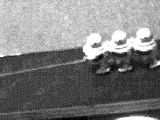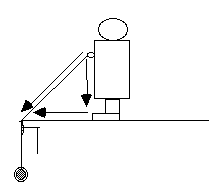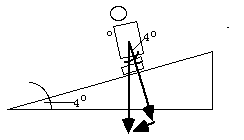
|
A bob, or mass, hangs from a string attached to the front of the walking men. Watch as the string almost draws the vectors that make the toy work. |
|
|
![]()
|
a) Have students hang the mass over the side of a desk and let the toy walk. Resist the temptation to stop the toy when it gets to the edge! Why doesn't it fall off? How does it "know" when to stop?

b) Remove the mass from the front of the toy. Place the toy on the board. Raise the board to an angle that just causes the toy to walk down the ramp. Use the angle of the ramp and the mass of the toy to calculate how much weight would have to be attached to the string to get it to move forward. |
![]()
|
Why does the toy walk? For the toy to move, you must apply a force that is at least as great as the frictional force trying to stop it. The weight of the mass pulls along the string and provides the force that results in the toy's motion. The string pulls diagonally, though, and only the horizontal component of the force makes the toy move forward.

As the toy gets closer to the edge, the angle of the pull changes. The component of force pulling forward gets relatively shorter, and the component pulling down gets relatively longer. At the edge of the table, there is no component of force pulling the toy forward, so it stops! Calculating the pulling mass When the toy stands on the ramp, the force that causes its motion comes from its weight. The weight vector, however, acts perpendicular to the table top, not the ramp. So again we break the vector into its components. The vector that is parallel to the ramp is responsible for the forward motion of the toy. The triangles created by the ramp and table and by the toy and ramp are similar, and the angles indicated are congruent.

Measure the angle between the board and the ramp as indicated in the drawing above. Get the mass of the toy. Find the mass of a small paper clip. You are now ready to find the number of paper clips necessary to pull the toy forward. The force required to overcome friction for forward motion can be calculated in the following way: sin ø = Force pulling /Force toy weight or Force toy weight(sin ø) = Force pulling For example: Weight of the toy: 0.021kg x 10m/s 2 *= 0.21N Weight of one paper clip: 0.00043kg x 10m/s 2 = 0.0043N To find the force necessary to overcome friction (the Force pulling ), use 0.21N (sin 4 o ) = 0.015N 0.015N necessary to pull/.0043N per paper clip = 3.4 or 4 paper clips needed to move the toy forward Attach the four paper clips to the toy, place on a level surface, and check to see if (with an initial push) it continues moving. The toy should move at least until the angle between the string and the toy is reduced to less than 4 o . (* 10m/s 2 used for simplicity) |
